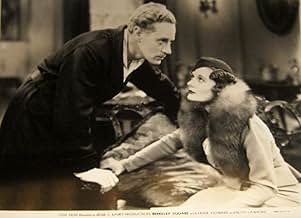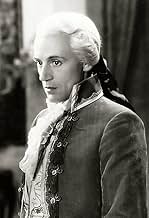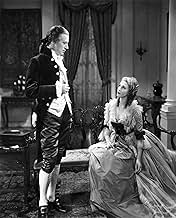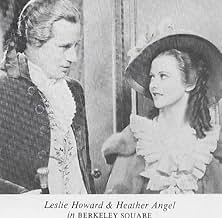Ajouter une intrigue dans votre langueA young American man comes to believe that he can will himself back to London in the time of the American Revolution and meet his ancestors, who lived in the house he has just inherited.A young American man comes to believe that he can will himself back to London in the time of the American Revolution and meet his ancestors, who lived in the house he has just inherited.A young American man comes to believe that he can will himself back to London in the time of the American Revolution and meet his ancestors, who lived in the house he has just inherited.
- Nommé pour 1 Oscar
- 1 victoire et 2 nominations au total
- The American Ambassador
- (as Samuel Hinds)
- Innkeeper
- (non crédité)
- Town Crier
- (non crédité)
- Maid
- (non crédité)
Histoire
Le saviez-vous
- AnecdotesS.T. Joshi points to this film as an inspiration for H.P. Lovecraft's novel "The Shadow Out of Time": "Lovecraft saw this film four times in late 1933; its portrayal of a man of the 20th century who somehow merges his personality with that of his 18th-century ancestor was clearly something that fired Lovecraft's imagination, since he had written a story on this very theme himself--the then unpublished "The Case of Charles Dexter Ward" (1927)." Lovecraft called the film "the most weirdly perfect embodiment of my own moods and pseudo-memories that I have ever seen--for all my life I have felt as if I might wake up out of this dream of an idiotic Victorian age and insane jazz age into the sane reality of 1760 or 1770 or 1780." Lovecraft noted some conceptual problems in this film's depiction of time travel, and felt that he had "eliminated these flaws in his masterful novella of mind-exchange over time."
- GaffesThe word Okay (OK) was not used in the 18th century.
- Citations
Peter Standish: A new Fire of London, that's what's needed here. Yes, and a new Plague too. Dirt, disease, cruelty, smells - Lord, how the eighteenth century stinks!
- ConnexionsReferenced in Don't Bet on Blondes (1935)
- Bandes originalesEarly One Morning
(uncredited)
English folk song
On a stormy night in 1784, new American noble Leslie Howard (as Peter Standish) arrives in London's "Berkeley Square" to seek a distant cousin's hand in marriage. After exiting his coach, Mr. Howard seems to vanish. Meanwhile, in the present (1933), his direct descendant and namesake "Peter Standish" (Howard, in a dual role) has inherited the same house. The modern Howard troubles his fiancée and friends due to his preoccupation with the past, especially the September 1784 day when his namesake arrived. Transported to the past, Howard invites suspicion when his "modern" manners and knowledge surface. Howard talks too much. More significantly, he becomes attracted to the wrong woman, beautiful but melancholy Heather Angel (as Helen Pettigrew)...
This intriguing "time travel" film was unavailable for decades, but the story was revived often on stage and screen. It was based on an unfinished Henry James novel and inspired memorable imitations from horror mythos-makers H. P. Lovecraft ("The Shadow out of Time") and Dan Curtis ("Dark Shadows"). Howard recreates his performance from the stage well, but director Frank Lloyd and Fox don't take full advantage of cinema potential. Early examples are Howard's trip to the past. He could have appeared outside the door, wet, as both arrivals occurred in the rain. Howard also immediately knows how to sit in his 1784 costume, betraying a familiar comfort. Later, the film would have benefited from Howard visiting the actual grave mentioned in a letter...
Solid impressions are made by lustful Colin Keith-Johnston (as Thomas "Tom" Pettigrew) and sensible sister Valerie Taylor (as Kate). Matriarchal Irene Browne (as Ann) played her role again in the 1941 re-make starring Tyrone Power.
******* Berkeley Square (9/15/33) Frank Lloyd ~ Leslie Howard, Heather Angel, Colin Keith-Johnston, Valerie Taylor
- wes-connors
- 22 mars 2015
- Permalien
Meilleurs choix
- How long is Berkeley Square?Alimenté par Alexa
Détails
- Durée1 heure 28 minutes
- Couleur
- Rapport de forme
- 1.37 : 1
Contribuer à cette page
































